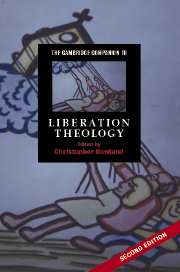Book contents
- Frontmatter
- Introduction: the theology of liberation
- Part I Contemporary Liberation Theology
- Part II Aspects of Liberation Theology
- Part III Analysis and Criticism
- 10 Liberation theology and the Roman Catholic Church
- 11 Marxism, liberation theology and the way of negation
- 12 The economics of liberation theology
- 13 Political theology, tradition and modernity
- 14 Globalising liberation theology: the American context, and coda
- Epilogue: the future of liberation theology
- Select bibliography
- Index
- Series list
10 - Liberationtheology and the Roman Catholic Church
from Part III - Analysis and Criticism
Published online by Cambridge University Press: 28 January 2008
- Frontmatter
- Introduction: the theology of liberation
- Part I Contemporary Liberation Theology
- Part II Aspects of Liberation Theology
- Part III Analysis and Criticism
- 10 Liberation theology and the Roman Catholic Church
- 11 Marxism, liberation theology and the way of negation
- 12 The economics of liberation theology
- 13 Political theology, tradition and modernity
- 14 Globalising liberation theology: the American context, and coda
- Epilogue: the future of liberation theology
- Select bibliography
- Index
- Series list
Summary
Medellín and the aftermath of the Second Vatican Council
It was from a situation of dependence on Europe that liberation theologianssought to free themselves. In so doing, they could call upon original traditionworth reviving. But the awareness of the tradition grew slowly. In 1968, theconventional date for the start of 'liberation theology' in the modern sense, thestress fell on what was new. The Latin American bishops, meetingat Medellín, made the crucial move. How was the Christian doctrine of'salvation' to be presented in terms that would be intelligible to the sufferingpeoples of Latin America? 'Salvation' always implies a metaphor, whether ofrestoration to health after sickness or 'redemption' from slavery. The LatinAmerican bishops decided that the best translation of 'salvation' for theiroppressed peoples was liberation. To be meaningful, however, theywould have to stand with their oppressed peoples. The phrase 'option for thepoor', first used in a letter from Pedro Arrupe to the Jesuits of Latin America inMay 1968, expressed this truth.
'Liberation theology' came into being to expand on and explain these two insights.Its originality consisted in the fact that it was not just a theology about liberation, as the theology of 'grace' was about grace.It was for liberation, promoting and propagating it. Likewise, itwas not just a theology about the poor, it was theology for the poor. So it would be an active practical theologyintended to make a difference in the real world: the Marxist concept of praxis indicated that. The stress of liberation theology layas much on orthopraxis (right action) as on orthodoxy (right thinking). Butdespite these claims to practical effects, liberation theology could only qualifyas serious theo-logos, discourse about God, if it spokerelevantly of God.
- Type
- Chapter
- Information
- The Cambridge Companion to Liberation Theology , pp. 209 - 228Publisher: Cambridge University PressPrint publication year: 2007
- 3
- Cited by

